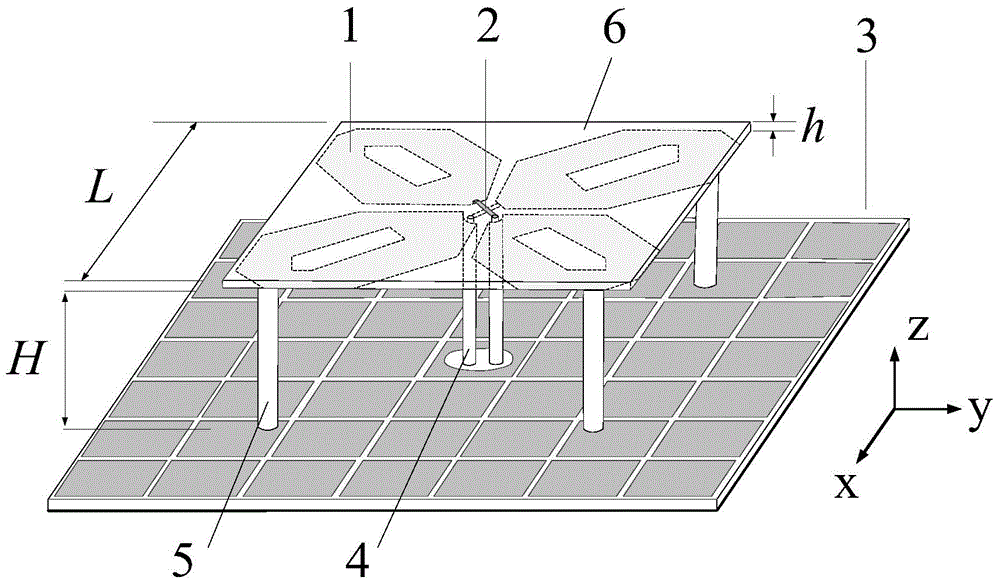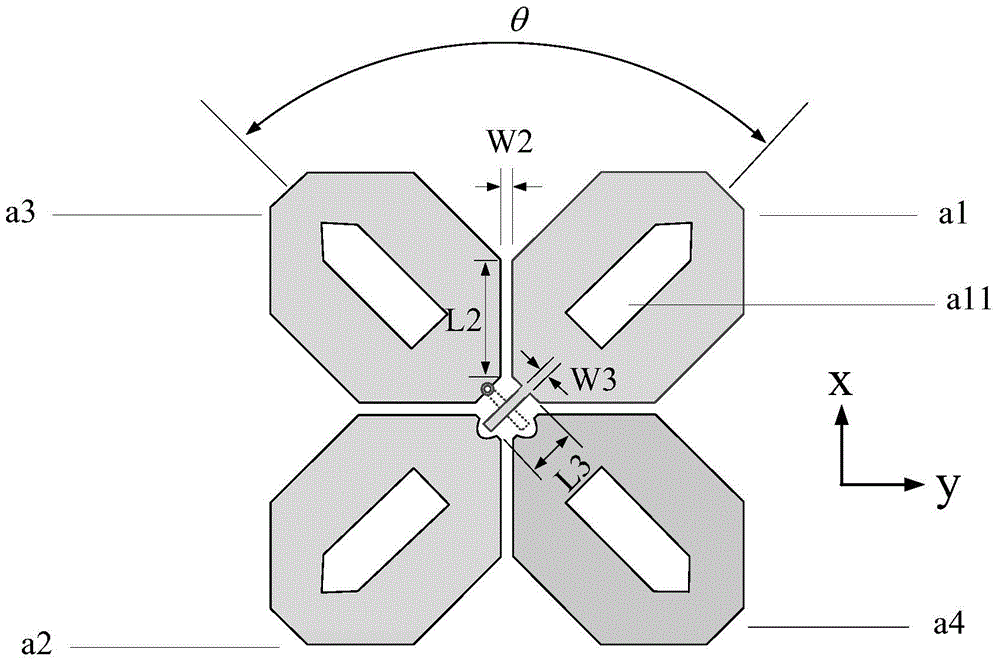Low-profile dual-polarized base station antenna
A base station antenna and dual-polarization technology, applied in the field of antennas and mobile communication base station antennas, can solve the problems of unfavorable miniaturization, high profile of dual-polarized base station antennas, and large size of reflectors, so as to increase integration and reduce size. , the effect of reducing the section height
- Summary
- Abstract
- Description
- Claims
- Application Information
AI Technical Summary
Problems solved by technology
Method used
Image
Examples
Embodiment 1
[0024] refer to figure 2 , the present invention includes a ±45° dual-polarized planar vibrator 1, a ±45° planar feed probe 2, an artificial magnetic conductor reflector 3, a coaxial line 4, a support column 5 and a dielectric material plate 6; the dielectric material plate 6 adopts The Rogers 5880 material with a dielectric constant of 2.2 has a square surface shape, its side length L is 37.4mm, and its thickness h is 0.508mm. There are metallized through holes on its +45° angle bisector; on this dielectric material plate The upper surface of the 6 is printed with a +45° planar feed probe, and the lower surface is printed with a -45° planar feed probe and a ±45° dual-polarized planar oscillator to achieve planarization and reduce the cost of large-scale processing. Cost; the artificial magnetic conductor reflector 3 is composed of an upper layer patch, a middle medium and a lower floor, and a feeding through hole is arranged in the center thereof, and the artificial magnetic...
Embodiment 2
[0028] Embodiment 2 has the same structure as Embodiment 1, and only the following parameters are modified: the side length L4=14mm of the square patch, the distance g1=1mm between adjacent square patches, the order N=6 of the square patch array, the feeding The length of the probe is L3=4mm, the width W3=0.5mm, the distance between the lower surface of the dielectric material plate and the upper surface of the artificial magnetic conductor reflection plate is H=10mm, and the thickness of the reflective medium plate is h1=4.5mm.
Embodiment 3
[0030] Embodiment 3 has the same structure as Embodiment 1, only the following parameters are modified: the side length L4 of the square patch = 17mm, the distance between adjacent square patches g1 = 1.2mm, the order of the square patch array N = 8, and the plane The length L3 of the feeding probe = 4.5mm, the width W3 = 1mm, the distance between the lower surface of the dielectric material plate and the upper surface of the artificial magnetic conductor reflection plate H = 11mm, and the thickness h1 of the reflective medium plate = 5.5mm.
[0031] Advantage of the present invention can be further illustrated by the simulation result of embodiment 1:
[0032] 1. Simulation content
[0033] The above-mentioned embodiment 1 is simulated by using the simulation software HFSS. Its port reflection coefficient and isolation are as Figure 5 As shown; when the +45° vibrator is fed by a single port, the horizontal plane far-field radiation pattern at the two frequency points of 2....
PUM
| Property | Measurement | Unit |
|---|---|---|
| Thickness | aaaaa | aaaaa |
| Side length | aaaaa | aaaaa |
| Thickness | aaaaa | aaaaa |
Abstract
Description
Claims
Application Information
 Login to View More
Login to View More - R&D
- Intellectual Property
- Life Sciences
- Materials
- Tech Scout
- Unparalleled Data Quality
- Higher Quality Content
- 60% Fewer Hallucinations
Browse by: Latest US Patents, China's latest patents, Technical Efficacy Thesaurus, Application Domain, Technology Topic, Popular Technical Reports.
© 2025 PatSnap. All rights reserved.Legal|Privacy policy|Modern Slavery Act Transparency Statement|Sitemap|About US| Contact US: help@patsnap.com



